 W
WThe predecessors to the contemporary Army of India were many: the sepoy regiments, native cavalry, irregular horse and Indian sapper and miner companies raised by the three British presidencies. The Army of India was raised under the British Raj in the 19th century by taking the erstwhile presidency armies, merging them, and bringing them under the Crown. The British Indian Army fought in both World Wars.
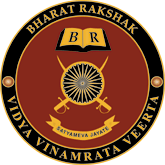 W
WBharat Rakshak is a website devoted to discussing India's military affairs. It was started and is run by military enthusiasts.
 W
WThe Army of the Mughal Empire was the force by which the Mughal emperors established their empire in the 15th century and expanded it to its greatest extent at the beginning of the 18th century. Although its origins, like the Mughals themselves, were in the cavalry-based armies of central Asia, its essential form and structure was established by the empire's third emperor, Akbar.
 W
WBacchawali Tope is a gun, rather cannon which lies in the Nizamat Fort Campus on the garden space between the Nizamat Imambara and the Hazarduari Palace and to the east of the old Madina Mosque in the city of Murshidabad in the Indian state of West Bengal. The cannon consists two pieces of different diameters. The cannon was made between the 12th and 14th century, probably by the Mohammeddan rulers of Gaur. It originally lied on the sand banks of Ichaganj. However, it is unknown that how it came in Ichaganj. It was used to protect the city of Murshidabad from north-western attacks. After the 1846 fire of the Nizamat Imambara the Imambara was rebuilt, then after the completion of the new Imambara the cannon was shifted to its present site by Sadeq Ali Khan, the architect of the sacred Nizamat Imambara under the suggestion of Sir Henry Torrens, the then agent of the Governor General at Murshidabad.
 W
WThe Battle of Saraighat was a naval battle fought in 1671 between the Mughal Empire, and the Ahom Kingdom on the Brahmaputra river at Saraighat, now in Guwahati, Assam, India. Although weaker, the Ahom Army defeated the Mughal Army by brilliant uses of the terrain, clever diplomatic negotiations to buy time, guerrilla tactics, psychological warfare, military intelligence and by exploiting the sole weakness of the Mughal forces—its navy.
 W
WList of important battles fought in India from 1000 CE up to 1757 CE.
 W
WThe regiments of Bengal Native Infantry, alongside the regiments of Bengal European Infantry, were the regular infantry components of the East India Company's Bengal Army from the raising of the first Native battalion in 1757 to the passing into law of the Government of India Act 1858. At this latter point control of the East India Company's Bengal Presidency passed to the British Government. The first locally recruited battalion was raised by the East India Company in 1757 and by the start of 1857 there were 74 regiments of Bengal Native Infantry in the Bengal Army. Following the Mutiny the Presidency armies came under the direct control of the United Kingdom Government and there was a widespread reorganisation of the Bengal Army that saw the Bengal Native Infantry regiments reduced to 45.
 W
WBharat Rakshak is a website devoted to discussing India's military affairs. It was started and is run by military enthusiasts.
 W
WThe Carnatic Wars were a series of military conflicts in the middle of the 18th century in India. The conflicts involved numerous nominally independent rulers and their vassals, struggles for succession and territory; and included a diplomatic and military struggle between the French East India Company and the British East India Company. They were mainly fought within the territories of Mughal India with the assistance of various fragmented polities loyal to the "Great Moghul". As a result of these military contests, the British East India Company established its dominance among the European trading companies within India. The French company was pushed to a corner and was confined primarily to Pondichéry. The East India Company's dominance eventually led to control by the British Company over most of India and eventually to the establishment of the British Raj.
 W
WThe First Carnatic War (1746–1748) was the Indian theatre of the War of the Austrian Succession and the first of a series of Carnatic Wars that established early British dominance on the east coast of the Indian subcontinent. In this conflict the British and French East India Companies vied with each other on land for control of their respective trading posts at Madras, Pondicherry, and Cuddalore, while naval forces of France and Britain engaged each other off the coast. The war set the stage for the rapid growth of French hegemony in southern India under the command of French Governor-General Joseph François Dupleix in the Second Carnatic War.
 W
WThe Chola Military was organized in the medieval era by emperor Rajaraja Chola I. The Cholas of the Vijayalaya Dynasty, who ruled parts of South India and Lanka between the tenth and thirteenth centuries CE, were dependent on their army and navy to expand and maintain order in their vast empire. Chola was the head of this army and navy.
 W
WClaude Auguste Court was a French soldier and mercenary.
 W
WAn elephant sword, also called a tusk sword, is an edged weapon designed to be attached to the tip of an elephant's tusk, normally used in pairs.
 W
WThe Fauj-i-Khas was a brigade of the Fauj-i-Ain section of the Sikh Khalsa Army of Punjab. It consisted of very experienced elites and had separate flag and emblem. It was strictly disciplined on French pattern. All the equipment and weapons were of the best type. It grew to be the best organised section of the regular army (Fauj-i-Ain)
 W
W"The Great Game" was a political and diplomatic confrontation that existed for most of the 19th century between the United Kingdom and the Russian Empire, over Afghanistan and neighbouring territories in Central and South Asia. It also had direct consequences in Persia and India. Britain was fearful of Russia invading India to add to the vast empire that Russia was building in Asia. As a result, there was a deep atmosphere of distrust and the talk of war between the two empires. Britain made it a high priority to protect all the approaches to India, and the "great game" is primarily how the British did this. Historians with access to the archives have concluded that Russia had no plans involving India, as the Russians repeatedly stated.
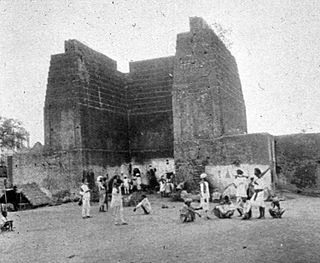 W
WThe Gunfoundry also known as Top ka Sancha was a cannonball factory set up by the second Nizam of Hyderabad, Nawab Mir Nizam Ali Khan at Fateh Maidan in Hyderabad, India. The historic Aliya High School for Boys.
 W
WThe Battle of the Hydaspes was fought in 326 BC between Alexander the Great and King Porus of the Paurava kingdom on the banks of the Jhelum River in the Punjab region of the Indian subcontinent. The battle resulted in a Greek victory and the surrender of Porus. Large areas of the Punjab between the Hydaspes (Jhelum) and Hyphasis (Beas) rivers were absorbed into the Alexandrian Empire, and Porus was reinstated as a subordinate ruler.
 W
WArmour in the Indian subcontinent was used since antiquity. Its earlier reference is found in the vedic period. Armour has been described in religious texts; including the Itihasa epics Ramayana and Mahabharat, as well as in the Puranas.
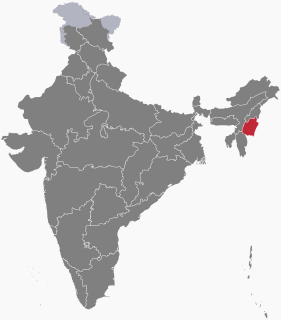 W
WThe Insurgency in Manipur is an ongoing armed conflict between India and a number of separatist rebel groups, taking place in the region of Manipur. The Insurgency in Manipur is part of the wider Insurgency in Northeast India; it combines elements of a national liberation war as well as an ethnic conflict.
 W
WThe Insurgency in Meghalaya is a frozen armed conflict between India and a number of separatist rebel groups which was taking place in the state of Meghalaya. The Insurgency in Meghalaya is part of the wider Insurgency in Northeast India, and was fueled by demands of the Khasi, Synteng and Garo people for a separate state.
 W
WKargil Vijay Diwas is a holiday observed in India on the 26th of July. On this date in 1999 India successfully took command of the high outposts. The Kargil war was fought for more than 60 days and ended on 26 July 1999, when the Pakistani army took advantage of the melting snow and - betraying the bilateral understanding of both the nations that the post would remain unattended during the winter season - took command of the high outposts of India. The Pakistani army denied involvement in the war, claiming that it was caused by independent Kashmiri rebel forces, however documents left behind by casualties and later statements by Pakistan's Prime Minister and Chief of Army Staff showed involvement of Pakistani paramilitary forces, led by General Ashraf Rashid. The Kargil war resulted in loss of life on both the sides and was ended when India regained control over the post and ejected the Pakistani Army out of the territory.
 W
WMalik Ambar was a Siddi military leader in the Deccan region of India.
 W
WMalik Kafur, also known as Taj al-Din Izz al-Dawla, was a prominent slave-general of the Delhi Sultanate ruler Alauddin Khalji. He was captured by Alauddin's general Nusrat Khan during the 1299 invasion of Gujarat, and rose to prominence in the 1300s.
 W
WMaratha Army refers to the land-based armed forces of the Maratha Empire, which existed from the late 17th to the early 19th centuries in India. The formation, rise, and decline of the armies of the Maratha Empire can be broadly divided into two eras
 W
WMartial race was a designation created by army officials of British India after the Indian Rebellion of 1857, where they classified each caste into one of two categories, 'martial' and 'non-martial'. The ostensible reason was that a 'martial race' was typically brave and well-built for fighting, while the 'non-martial races' were those whom the British believed to be unfit for battle because of their sedentary lifestyles. However, an alternative hypothesis is that British-trained Indian soldiers were among those who rebelled in 1857 and thereafter recruitment policy favoured castes which had remained loyal to the British and diminished or abandoned recruitment from the catchment area of the Bengal Army. The concept already had a precedent in Indian culture as one of the four orders (varnas) in the Vedic social system of Hinduism is known as the Kshatriya, literally "warriors". Brahmins were described as 'the oldest martial community', in the past having two of the oldest regiments, the 1st Brahmans and 3rd Brahmans.
 W
WThe Military of Vijayanagara supported the Vijayanagara Empire in particular with regard to the empire's long-lasting rivalry with the Bahmani Sultanate. Besides a large standing army, the Vijayanagara rulers also maintained a powerful navy. This helped make the Viayanagara empire the most centralised polity ever to have emerged in South India. However, a major portion of the imperial income was committed to military purposes, straining the economy.
 W
WThe Mughal conquest of Garha was launched by the Mughal Empire in 1564 during the reign of Akbar against the Garha Kingdom led by regent Rani Durgavati. The Mughal general Asaf Khan I launched the attack with the permission of Akbar and easily defeated the Rani's forces, which could not withstand advanced Mughal artillery, at the Battle of Damoh. The Rani committed suicide during the battle and the young prince Vir Narayan died in action during the Siege of Chouragarh. The women trapped in the siege committed jauhar before Asaf Khan could take the fortress.
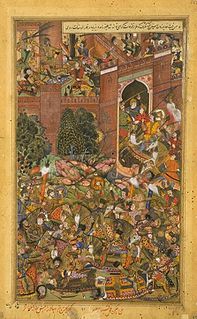 W
WThe Mughal conquest of Malwa was a military campaign launched by the Mughal Empire in 1560 during the reign of Akbar against the Sultanate of Malwa, which had broken free from Mughal rule during the rebellion of Sher Shah Suri from the emperor Humayun. Thus, Akbar had a claim to the province. Baz Bahadur had been the governor of Malwa in the Sur Empire but broke away after the death of Sher Shah.
 W
WMurarbaji Deshpande was a general in the early Maratha Empire during the reign of Shivaji. He is best remembered for his defense of the Purandar Fort against Dilir Khan, a Mughal general who accompanied Mirza Raja Jai Singh in the 17th-century siege on Purandar.
 W
WThe Nair Brigade was the army of the erstwhile kingdom of Travancore in India. Nairs were a community of the region. The personal bodyguard of the king Marthanda Varma (1706–1758) was also called Thiruvithamkoor Nair Pattalam. The Travancore army was officially referred as the Travancore Nair Brigade in 1818.
 W
WNetoji Palkar (1620–1681) was a Sardar Senapati or Sarnaubat (Commander-in-Chief) under Shivaji, founder of the Maratha empire.
 W
WThe Ottoman-Portuguese conflicts of 1538 to 1559 were a series of armed military encounters between the Portuguese Empire, the Kingdom of Hormuz, and the Ethiopian Empire against the Ottoman Empire and Adal Sultanate, in the Indian Ocean, the Persian Gulf, the Red Sea, and in East Africa. This is a period of battles in The Ottoman-Portuguese War.
 W
WThe Ottoman–Portuguese Conflicts (1586–1589) were armed military conflicts between the Portuguese Empire and the Ottoman Empire in the Indian Ocean, specifically in the east-African coast.
 W
WThe Pindaris were irregular military plunderers and foragers in 17th- through early 19th-century Indian subcontinent who accompanied initially the Muslim army, later the Maratha army, and finally on their own before being eliminated in 1817-18 Pindari War. They were unpaid and their compensation was entirely the loot they plundered during the war. They were horsemen, foot brigades and partially armed, creating chaos and delivering intelligence about the enemy positions to benefit the army they accompanied. The earliest mention of them is found during Aurangzeb's campaign in the Deccan, but their role expanded with the Maratha armed campaign against the Mughal empire. They were highly effective against the enemies given their rapid and chaotic thrust into enemy territories, but also caused serious abuses against allies such as the Pindari raid on Sringeri Sharada Peetham in 1791. After several cases of abuse where the Pindaris plundered the territories of Maratha allies, the Maratha rulers such as Shivaji issued extensive regulations upon the Pindari contingent seeking to carefully limit their predatory actions.
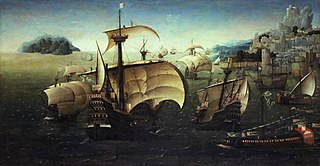 W
WThe Portuguese Indian Armadas were the fleets of ships, organized by the crown of the Kingdom of Portugal and dispatched on an annual basis from Portugal to India, principally to Portuguese Goa and other colonies such as Damaon. These armadas undertook the Carreira da Índia, following the sea route around the Cape of Good Hope first opened up by Vasco da Gama in 1497–1499.
 W
WBefore the Muslim conquests in the Indian subcontinent, much of northern and western India was being ruled by Rajput dynasties. The Rajput kingdoms contended with the rising and expansionist empires of the Muslim world, be they Arabs, Turks, Pashtuns, or Mughals. The Rajputs held out against the Caliphates and Central Asian empires for several centuries.
 W
WThe Sikh Khalsa Army (Punjabi: ਸਿੱਖ ਖਾਲਸਾ ਫੌਜ, Khalsa or simply Sikh Army was the military force of the Sikh Empire, formed in 1799 with the capture of Lahore by Ranjit Singh. From then on the army was modernized on Franco-British principles. It was divided in three wings: the Fauj-i-Khas, Fauj-i-Ain and Fauj-i-Be Qawaid. Due to the lifelong efforts of the Maharaja and his European officers, it gradually became a prominent fighting force of Asia. Ranjit Singh changed and improved the training and organisation of his army. He reorganized responsibility and set performance standards in logistical efficiency in troop deployment, manoeuvre, and marksmanship. He reformed the staffing to emphasize steady fire over cavalry and guerrilla warfare, improved the equipment and methods of war. The military system of Ranjit Singh combined the best of both old and new ideas. He strengthened the infantry and the artillery. He paid the members of the standing army from treasury, instead of the Mughal method of paying an army with local feudal levies.
 W
WThe Battle of the Nedumkotta took place on 28 December 1789, and was a reason for the opening of hostilities in the Third Anglo-Mysore War. This battle was fought between Tipu Sultan of the Kingdom of Mysore and Dharma Raja, Maharaja of Travancore. Mysore army attacked the fortified line at the Travancore border known as the Nedumkotta in Thrissur district. The Mysore army was successfully repulsed by Travancore army under the leadership of Raja Kesavadas Dewan of Travancore
The Tokyo Cadets or the Tokyo Boys, was the name given to the group of forty five youth recruits of the Indian National Army who were sent to the Imperial Japanese Army Academy or Imperial Japanese Army Air Force Academy to train as fighter pilots in 1944 by Subhas Chandra Bose. The cadets were captured as prisoners of war after Japan surrendered, but were released in 1946 after the end of the INA trials. The cadets became officers in the Indian forces, Burma Navy, Pakistan forces, and private pilots. Some of them became general officers.
 W
WThe Tripartite Struggle for control of northern India took place in the ninth century. The struggle was between the Pratihara Empire, the Pala Empire and the Rashtrakuta Empire.
 W
WThe Battle of Vijaydurg, also known as the siege of Vijaydurg, was fought between Tulaji Angre, a Maratha Sardar and joint forces of the East India Company and Peshwa.
 W
WThis is a list of wars involving the Republic of India and its predecessor states.